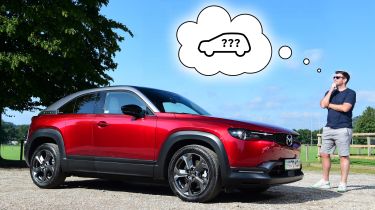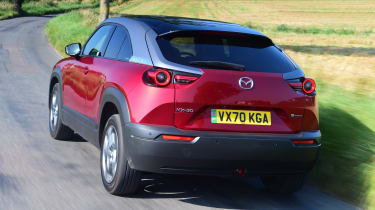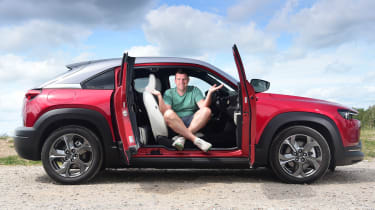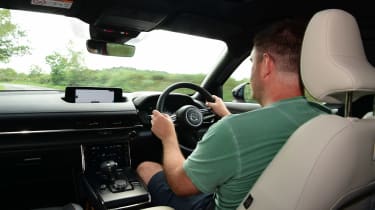Mazda MX-30 GT Sport Tech: long-term test review
Final report: our final thoughts as the quirky Mazda MX-30 electric coupe-SUV ends its six-month stint on our fleet

Verdict
We warmed to the Mazda MX-30 during its time with us. It’s certainly not without its foibles, but we can certainly see how it would appeal as an urban runabout. It’s best as a second car for families, though.
- Mileage: 2,756
- Efficiency: 3.8 miles/kWh
What do I make of the Mazda MX-30? The rear-hinged-doored electric coupé-SUV has charmed, frustrated and baffled during its six months with me, but it feels like we’re much closer to understanding it than I was back when it rolled off the lorry. There are undeniable issues with Mazda’s enigmatic electric runabout, but they can all be solved at a stroke with one simple measure: getting another car.
This isn’t as bad as it sounds. It’s not a suggestion that prospective buyers should look elsewhere, but rather that Mazda’s creation works so much better as a second car, in tandem with something else. Unless your driving is exclusively over short trips with one or two passengers, you’re likely to find yourself regularly wishing for a vehicle with more range, more space, or both, to overcome the Mazda’s shortcomings.
We’ve been using it as the only car for a young family of four, so these limitations have been exposed. I wouldn’t labour this point if we were talking about a city car here, but the MX-30 is longer than rival electric SUVs like the Hyundai Kona Electric and Vauxhall Mokka-e, both of which offer greater ranges and more rear-seat space. At 4,395mm, the Mazda is 551mm longer than a Honda e and 763mm longer than a Fiat 500, but it’s these compact electric city cars that most closely match its cabin space and range.
Used - available now

2023 Land Rover
Range Rover Evoque
29,191 milesAutomaticDiesel2.0L
Cash £31,750
2020 Kia
Stonic
23,695 milesAutomaticPetrol1.0L
Cash £13,106
2021 Ford
Mustang Mach-E
24,663 milesAutomaticElectric
Cash £23,500
2020 BMW
1 Series
48,003 milesManualPetrol1.5L
Cash £15,897The one big exception here is the boot, because the Mazda has a large load bay, at 341 litres. It’s bigger than those of SUVs mentioned above and significantly more roomy than anything you’ll find in a city car.
Having got the MX-30’s somewhat unorthodox market positioning out of the way, we can get onto its strong points. The small 35.5kWh battery means you can get an MX-30 for just over £26,000, once the plug-in car grant has been applied. That’s cheap for an electric SUV in today’s market and on a par with the Honda e. The small battery means charging is quick; roughly five and a half hours from a 7kW home wallbox or around 36 minutes to go from 10 to 80 per cent on a 40kW fast charger. It makes the official range of 124 miles slightly less of an issue, even when we got closer to 110 miles from a full charge on average.
Concentrate on how the Mazda makes you feel and the scorecard is a lot more promising. The MX-30 is a fun car to drive. Mazda has intentionally tried to replicate the progressive power delivery of a petrol car, rather than giving you all the shove at once, but it still feels faster than the 9.7-second 0-62mph time suggests.
More importantly, the MX-30 is wieldy and responsive on the open road, hiding its 1,675kg kerbweight very well. The steering and pedal control weights feel natural, with more feedback and feel than we’re used to in an EV. The ride is firm on bumpy surfaces but the damping gives it smoothness and poise that I appreciated.
The unusual cabin materials – cork trim and recycled cloth – bring some character and, despite our fears, have shown no sign of wear and tear during our test. Even the light “stone” leatherette on the seat edges, which looked like a magnet for grime, has resisted marking and stains admirably.
Away from the funky trim choices, the MX-30’s cabin is very well built. The infotainment system is easy to use, too, and largely validates Mazda’s decision to go with a dial-operated set-up rather than a touchscreen. Things become less seamless when using Android Auto, as I often do, because it’s more tailored to touch inputs.
It just needs a bit of practice.
The MX-30 took time to truly understand, primarily because it isn’t really like other cars on the market. The curious mix of strengths and weaknesses will deter some buyers, but those that can live with the range and cabin space will find a fun, quirky EV that rewards on financial and emotional levels. If you simply can’t imagine gelling with the Mazda, I can sympathise, but could it be you just need another car to go with it?
Mazda MX-30: second report
Our Mazda MX-30 is making us feel guilty after we chickened out of taking it on a holiday road-trip
- Mileage: 2,210
- Efficiency: 3.8 miles/kWh
I’d like to start with a confession: I left the Mazda MX-30 at home when I went on holiday this summer, because I couldn’t face doing a 260-mile drive to Wales in an electric car with a 124-mile range. There were other reasons – the tight rear legroom would have raised the “Are we there yet?” crescendo from the back seats by several decibels – but the main one was that, having considered the prospect of an essential interaction with the UK’s public charging network, I bottled it.
I’m not proud of my decision. I’m all in favour of the electric vehicle revolution, and believe that a lot of the concerns around range and charging are overblown when viewed in line with typical UK car-usage patterns. Yet if someone like me decides to duck out of the EV experience the moment a long journey presents itself, it does highlight many buyers’ reluctance to take the plunge.
To be fair, the little MX-30 SUV wasn’t made to take a family of four 200-plus miles for a week at the beach. People have gasped when I’ve told them it will officially do only 124 miles on a full charge (110 is closer to the average). But many hardly ever drive 100 miles in a day, and most will never do so in their second car – or even in their first if it’s a supermini or small SUV.
In an urban-runabout role, the MX-30’s range isn’t an issue. Better still, brimming the battery at home, where 30kWh costs about £5, is highly cost effective – akin to a 100mpg-plus petrol car, even before the tax breaks. What’s more, you can buy a well specced First Edition for £325 per month after a £4,265 deposit, whereas a lower-spec, petrol CX-30 SE-L (48mpg) is £295 after a £3,652 deposit. Not a huge difference.
If you do want to go further, the longest-range EVs can now top 300 miles – enough for our journey from Surrey to west Wales, with a bit to spare. But I wonder how much range would be enough for me to travel so far from the security of my home charger?
Public charging is a hot topic. EV advocates extol the growing infrastructure and the fact that most EV drivers will hardly ever have to use it. The doubters point to the not-uncommon tales of drivers desperate for juice visiting one engaged or broken charger after another while watching their range figure ticking down toward catastrophe.
My thinking is this: if I could have taken the MX-30 away making one recharge stop en route, I would have done so. A 50kW fast charger would replenish the 35kWh (30kWh usable) battery from 10 to 80 per cent in around 39 minutes, so we’d have been on our way in the time it took to have a coffee and use the service station facilities.
But as it turned out, there was no easy way of charging at our destination short of dangling a cable out of a window and parking across a minor road. Visiting local public chargers would have required specific trips – and most were not rapid types. It would have been possible but inconvenient when I was meant to be on holiday.
If the MX-30 had the 300-mile range of larger, more costly electric SUVs such as the VW ID.4 and Hyundai Kona EV, I could have done the trip easily and probably charged twice while away – once to get around, and again to get home. That isn’t much more inconvenient than filling up with fuel, but in months of using the car I’d never needed much more than 100 miles of range in a day.
Anxiety about range, infrastructure and simply whether we can successfully live with EVs is real – I’ve felt it. We all face a big change, so it’s only natural. Early adopters shouldn’t dismiss these doubts; it’s not constructive, and the concerns are genuine.
The stylish, quirky and sharp-driving MX-30 is designed for a job – and this wasn’t it. I was lucky enough to have an alternative car to use, and I’m confident this made the trip far more enjoyable. As tech improves, costs come down and model ranges expand, there’ll be fewer people for whom an EV is a non-starter. Charging infrastructure needs to get much better so that prospective EV buyers see those rare longer trips as a formality, not a step into the unknown. We’ll get there, though; the MX-30 has a sparkling record on our fleet so far. Ducking out of this trip is simply the exception that proves the rule.
Mazda MX-30: first report
The delightfully different Mazda MX-30 EV opens up to reveal its charms – and a few weaknesses
- Mileage: 1,342
- Efficiency: 3.3 miles/kWh
Where some manufacturers tend to do their car designs largely by the book, Mazda has long since lost its library card. The Japanese brand has a history of bold innovation, and the MX-30 continues that.
This is a small SUV with an electric powertrain and a relatively small 35.5kWh battery, delivering just 124 miles of range. It’s a five-door car but, like Mazda’s RX-8 sports car from the early noughties, the rear doors open the opposite way to the front ones, creating a wide opening with no B-pillars. There’s a long bonnet with very little under it, a large boot and a classy cabin, finished with eco-friendly cork and recycled fabric, yet not blessed with a lot of rear passenger space.
Mazda is confident that there’s a ready market out there for this non-conformist creation. A long-term test would seem the perfect vehicle to discover if it’s right.
Our MX-30 is a GT Sport Tech model with a £32,145 price tag after the Government’s Plug-in Car Grant has been deducted. It sounds like a lot of money for a small SUV but this is the top-spec model in a range that opens at just over £26,000, and it leaves very little off the equipment list.
Get into the driver’s seat and the MX-30 continues to raise eyebrows. First, the cork. The storage areas are lined with sustainably sourced sheets of the stuff and it’s a measure of the MX-30’s unique approach that this isn’t the only feature of the car that makes you wonder just how much wine they must be drinking at Mazda HQ.
There are more interesting – and eco-friendly – material choices on the window sills and the seats, with our car getting the ‘light grey cloth with stone Leatherette’ interior. It looks great so far but how will it shape up after sustained use?
The general design and build quality inside the MX-30 are real strengths. But things do come unstuck when you get to grips with the practicalities of it. In the front you can get a really comfortable driving position, with lots of adjustment on the seat and steering column, but rear legroom is really poor compared with many rivals. At just over six feet tall, I have to seriously sacrifice that ideal driving position to get the kids in the back. Plus once you’re in those rear seats, the chunky window frames on the doors make it quite dark in there.
At 4,395mm long by 1,795mm wide, the MX-30 actually has a footprint that’s larger than the likes of the Vauxhall Mokka-e and Hyundai Kona Electric, but translates that into significantly less rear passenger room.
The boot is a big 341 litres, but it’s the large and largely empty area under the long bonnet that wastes the space. Presumably that room is being saved for the petrol-powered range-extender generator that is heavily tipped to join the MX-30 range in due course.
One of the main benefits of electric cars is the relatively compact size of the motor and batteries, allowing more space to be given over to people. And while the MX-30, Mokka-e and Kona Electric are not based on purpose-designed EV platforms, the Mazda definitely does the least efficient job of delivering on those advantages. If you look at the VW ID.3 you’ll find a car on an EV platform that’s 134mm shorter and 14mm wider than the MX-30, yet has massively more space for passengers inside.
And finally we come to the car’s range. Officially you can get 124 miles out of the Mazda MX-30 on a full charge. So far, I’m getting closer to 110 miles in warm weather and mainly urban driving, which equates to about 3.3 miles per kWh.
The small battery means it’s fast to charge (about 5h 30mins to go from empty to full on my 7.4kW wallbox charger, if you ever needed to do that) but that range figure is going to put doubts in the minds of some buyers. The Vauxhall Mokka-e and Peugeot e-2008 can manage 200 miles from their 50kWh batteries, while Hyundai’s Kona Electric can do either 189 miles with a 39kWh battery or 278 miles with a 64kWh.
It’s early days for the MX-30 on our fleet, but already it’s showing an innate ability to divide opinion and not conform to the market. The doors, the range, the cabin space, the design – this is not your average small SUV and it feels like it’ll be a really interesting car to explore further. Could it be that Mazda really does know best?
| Model: | Mazda MX-30 GT Sport Tech |
| On fleet since: | April 2021 |
| Price new: | £30,345 (after Govt. grant) |
| Engine: | Single 143bhp electric motor, 35.5kWh battery (30kWh usable) |
| CO2/tax: | 0g/km/£0 |
| Options: | Three-tone metallic paint (£1,800) |
| Insurance*: | Group: 19/Quote: £418 |
| Mileage: | 2,756 |
| Test efficiency: | 3.8 miles per kWh |
| Any problems? | None |
*Insurance quote from AA (0800 107 0680) for a 42-year-old in Banbury, Oxon, with three points.















